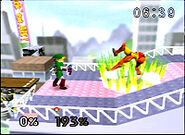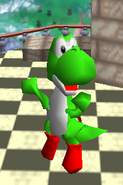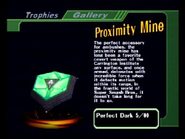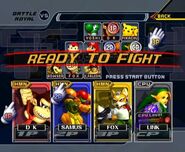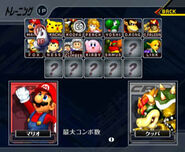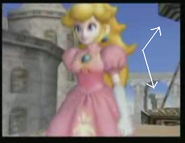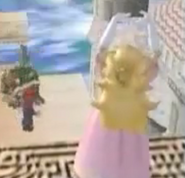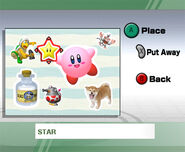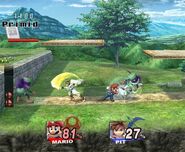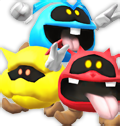Beta Elements are components of the Super Smash Bros. series that, for whatever reason, are removed or altered before that game is released. Known info about beta elements usually comes from one of two sources. The first is information released about a game, by its creators, before the game is complete. The second is data found within the coding of a game that serves no purpose, but could have been implemented into the game at one point.
Super Smash Bros.
Super Smash Bros. was initially developed by Masahiro Sakurai and Satoru Iwata in their downtime, in a form titled 格闘ゲーム竜王 (Kakuto-Gēmu Ryūō, or Dragon King: A Fighting Game), which lacked Nintendo characters. Sakurai, however, felt that the game could not provide the proper atmosphere on a home console without Nintendo characters, and they were soon added and the game was renamed.[1]
In the final game, two beta Kirby stages are only playable with a GameShark. The stages have strange elements, such as invisible barriers. A working Dream Land stage can be viewed in the "How to Play" tutorial, which itself can be seen by waiting on the title screen. Also, in the character select, the question mark boxes were supposed to be colored and Saffron City had pink with purple on the rooftop.
Bowser, Mewtwo, and King Dedede were originally planned to be playable, being scrapped due to a lack of development time.[2] It is believed that Pit, Wario, Princess Peach, and Meowth were also considered at some point, though this has considerably less evidence.
Also, according to a recent talk between Masahiro Sakurai and Satoru Iwata, Sakurai revealed he intented to add the Final Smashes in this game; with the proof he already had the voices effects when the characters uses their Final Smash, but for some limitations the Final Smash had to wait 9 years until the launch of Brawl.[3] In fact, just a few of these sound effects are already in the game, but as mentioned, were never used. These sounds include Ness yelling, "PK Starstorm!", Pikachu charging energy, and Captain Falcon saying, "Come on!" and "Blue Falcon!" Other characters heard include Fox, Kirby and Link. In addition to the unused Final Smash clips, there are three unused Announcer voice clips: "Are you ready?" "Final Stage" "Bonus Stage" and an unnamed Fanfare.[4]
Unused Audio
(BGM#11) A brief fanfare, it was probably going to be used as a standard victory theme for all the characters, this was replaced by giving a victory theme to every character, based on the universe they're from. The following are unused Final Smash clips, recorded for some characters, most of them are divided in two clips: A metallic friction sound and Samus shooting a projectile of ambiguous description with her Arm Cannon. Both of these sounds still exist in Melee.
Kirby making an odd grunt and yelling, separated in two sounds.
Fox saying "ike!", a Japanese term usually translated as either "come on" or "let's go". Was probably going to be the Landmaster afterwards...
Pikachu saying "Pika..." and hoarsely "chuuuuu!" separated in two sounds. This would later return in Brawl for its Final Smash, Volt Tackle, though these sound clips clearly weren't intended for that particular move; Volt Tackle is based on a move originated from Pokémon Ruby and Sapphire, released nearly four years after the game's release.
Captain Falcon saying "come on!" It was re-recorded for Melee but was kept as an unused sound, then used in Brawl as part of his Final Smash and a taunt, and only present in the Japanese version, "Blue Falcon!" It was re-recorded for Melee, who also kept this as an unused sound, and finally used in Brawl as a part of his Final Smash. It may also have been intended for his animation of entering the stage, when he exits the Blue Falcon.
Ness saying "PK" and "Starstorm!" separated in two sounds. This concept and sounds would later return in Brawl as his Final Smash.
Super Smash Bros. Melee
Through an Action Replay, a large, gray stage with the background appearing to be some kind of pub, is accessible. The music is the same as used on Fox and Falco's stage Corneria. This is assumed to be a test stage because of its name, which on the debug menu is TEST. There are also four stages, named AKANEIA (a possible predecessor to Castle Siege from Super Smash Bros. Brawl, a homeworld for the Fire Emblem series), 10-2, IceTop (a possible precursor to the Summit stage from the sequel, which belongs to the Ice Climbers), and DUMMY; all four freeze when accessed normally, though 10-2, IceTop and DUMMY can be accessed with other cheats, while AKANEIA remains inaccessible to this day. In addition to this, the entire Debug Menu, which was used in pre-release testing, can be used when the game is hacked, allowing for complete editing of anything in the game. Giga Bowser, both male and female Fighting Wire Frames, Master Hand, Crazy Hand, and even Sandbag are all playable (to a limited extent) via the Debug Menu. The game was also to only have 10 starter stages: Princess Peach's Castle, Kongo Jungle. Great Bay, Brinstar, Yoshi's Story, Fountain of Dreams, Corneria, Pokémon Stadium, Mute City, and Onett.[5] Oddly enough, some stage placement was different, notably Brinstar being on the top row and Corneria being in the middle.
Early screenshots showed the Motion-Sensor Bomb to be much different; these screenshots actually showed it to be a Proximity Mine from Perfect Dark rather than the Motion-Sensor Bomb from "TOP SECRET" (actually GoldenEye 007) that appeared in the final game. A screenshot of this Proximity Mine's trophy has also been released, and this screenshot shows that (in an almost cheap manner) the text in the Proximity Mine trophy was only tampered minorly (with only a few removals of references to Perfect Dark) for the final Motion-Sensor Bomb trophy. Why the Perfect Dark Proximity Mine was changed to a GoldenEye 007 Motion-Sensor Bomb remains unknown to this day and is rather ridiculous, especially considering that the games from which the items originated were even made by the same company, although the fact that Nintendo hides the Motion-Sensor Bomb's trophy's debuting game entry with the words "TOP SECRET" in the final game suggest that the item change may very well have had to do with copyright infringement. The Temple stage originally had an elevator that led to the bottom of the stage, as well as two strange platforms. These platforms strangely appear in the game's "Special Movie", when Peach is introduced. Players could also could walk through the laboratory in Great Bay. Stages Yoshi's Story, Yoshi's Island, Kingdom had different designs altogether; the first had a design where the rightmost walkable part was a plateau followed by a curved path up to another plateau; the second was larger and had more blocks, while the third looked more similar to the Mushroom Kingdom of the previous game. Early images of Pokémon Stadium shows different element icons in the background screen, which looked more alike the icons of the Pokémon Trading Game Cards. Eagleland: Onett was also titled Eagle Land: Onett and had music that sounded different.
Unused Audio
(FF_BAD.HPS) An unused fanfare. It might have been used when a Bonus Stage was lost, note that the prefix "FF" probably means "fanfare".
(FF_GOOD.HPS) Another unused fanfare similar to the one above. Was probably used at one point in development for when a Bonus Stage was won.
(FF_STEP1.HPS) A fanfare. The term "Step" is also used internally in Brawl to refer to the music used in the Subspace Emissary mode (and for a few cut tracks in the same stead), and the themes used in the Subspace levels are referenced as such in the game's sound test. Consequently, these themes were very likely intended for either Classic or Adventure.
(FF_STEP2.HPS) Another one following the one above.
(FF_STEP3.HPS) Yet another fanfare following the one above.
(S_NEW2.HPS and SFX_FPON_NEWFANF2) Can be accessed in the Sound Test as "Rare Trophy!", but is still unused. Take note that a remastered version of this fanfare is used in Brawl, and was remastered again as the character unlock sound in SSB4.
(SFX_PKV_METAMAN) Ditto crying "Mon-mon!" (Ditto's japanese name), who would've come out of a Poké Ball. This can be listened to via debug mode when forced to spawn a Poké Ball with Ditto.
(SFX_IT_CLOCKBOMB_COUNT) A looping ticking sound. Its file name suggests it was for an early item that would have exploded after some sort of countdown.
(SFXNR_HOWTOPLY) The announcer saying "How to Play!" This can be listened to in the Sound Test, not requiring any debugging, but it's still unused. NR probably stands for Narrator.
(SFXNR_AND) The announcer saying "And!" It can be listened to in the Sound Test, not requiring any debugging, but it's still unused. Most likely used in Classic mode for when you fight against two opponents, this concept would've lately be used in Brawl.
(SFXNR_WINS) The announcer saying "Wins", which in first game was used during Team Battles "Red/Blue/Green Team Wins!"). It can be listened to in the Sound Test, not requiring any debugging, but it's still unused.
(SFXV_CAPTAIN_BLUEF) Captain Falcon saying Blue Falcon!, this one existed (but remained unused) in the japanese version of the first game, and would've later be used in Brawl as his Final Smash quote.
(SFXV_CAPTAIN_COMEON) Captain Falcon saying "Come on!" This would later be used as a taunt (and part of his Final Smash) in Brawl.
(SFXV_DRMARIOB_2BIG) Clone leftovers. It's Mario's getting big sound.
(SFXV_DRMARIOB_2BIG) A lower-pitched version of the above.
(SFXV_DRMARIOS_2BIG) A higher pitched version of the above.
(SFXV_LUIGI_2BIG) (SFXV_LUIGIB_2BIG) (SFXV_LUIGIS_2BIG)
The same set of sounds for Luigi, but different-pitched and different speed.
(SFXV_GANON_KIRIFUDA) Ganondorf yelling angrily. This clip can be heard in the Sound Test without using any debugging routines. "Kirifuda" (Japanese: 切り札 or 切札) means a "trump card" or "last resort" in Japanese, strongly suggesting that it could've been for a Final Smash, whose Japanese name, Saigo no Kiri Fuda (最後の切りふだ), translates to Final Trump Card. Oddly, it would eventually end up being used in Brawl as the Wii Remote sound effect played when selecting Ganondorf.
(SFXV_MARIO_KIRIFUDA) Mario's trademark "Let's-a-go" (when choosing a Star in Super Mario 64) which was pitched up for Luigi in this game, as one of his Victory Poses. The use of "kirifuda" in the filename, similarly to Ganondorf's clip above, implies it may have been intended for a Final Smash back when they were still being considered in development.
(SFXV_MARS_LETSDANCE) Marth saying "Let's dance!" Sounds like something that would be used for a taunt, or possibly a Final Smash (but note it lacks KIRIFUDA). Even if it was used, it wouldn't fit on him since all of his lines in the game are in Japanese.
(SFXV_PIKACHU_SUTEMI) An audio clip of Pikachu yelling ferociously. Can be listened to via the in-game Sound Test. "Sutemi" is a Judo technique which involves throwing an opponent while the user is positioned on their back or sides, so this was likely intended for Pikachu's backwards throw, itself an exaggerated depiction of the move, though.
(SFXV_PICHU_SUTEMI) The same one for Pichu, the way to find it is the same as the one above.
(SFXNR_ZAKOTEAM) The announcer saying "Fighting Wire Frames!". It can be listened to in the Sound Test, not requiring any debugging, but it's still unused.
(SFXNR_GIGAKOOPA) The announcer saying "Giga Koopa". It can be listened to it in the Sound Test if the language is set to English, not requiring any debugging, but it's still unused.
(SFXNR_GIGABOUCER) The announcer saying "Giga Bowser". It can be listened to it in the Sound Test if the language is set to Japanese, not requiring any debugging, but it's still unused. Oddly, the filename reads BOUCER instead of BOWSER.
(SFXNR_MASTERHANDS) The announcer saying "Master Hand". It can be listened to it in the Sound Test, not requiring any debugging, but it's still unused, since there's no VS screen for Master Hand in Classic Mode.
Super Smash Bros. Brawl
Some of the game world icons were initially the same as in the previous two games, but they were revised as time went on (Mario's Mushroom icon was refined and given spots, the Poké Ball icon has the top half colored in to properly represent how it is usually red, etc.). Also, the description for the My Music options originally said, "Adjust how often a song will appear on this stage." It has since been revised in a general tone to say, "Adjust how often songs appear on stages." Along with this, one piece of music that was planned for the Delfino Plaza stage was later moved to Luigi's Mansion. Solid Snake was also meant to be more muscular, and was to have a gray suit rather than blue; along with this, his down smash mine looked different. Wario Bike, Drill Rush, Summit, Halberd, Rainbow Cruise, and "The Flowers That Bloom in the Echoes" were originally called Wario Chopper, Triple Dash, The Summit, Battleship Halberd, Rainbow Ride, and, "Flowers Bloom on the Notes" respectively. It's unknown why they changed these names, however, they likely changed Rainbow Ride because it was a Melee stage, in which it was misnamed Rainbow Cruise (although it remains Rainbow Ride in the PAL regions, mostly because it was called Rainbow Ride on the PAL version of Melee). Lastly, there were scenes taking place before the events of the Subspace Emissary where the Subspace Army takes over the Halberd and King Dedede unintentionally stalls Meta Knight from preventing it from happening. Masahiro Sakurai confirmed that he decided to cut this out and an update was made to confirm this together with how various events and characters in the Subspace Emissary comes together. Also Mario instead of Kirby was the one seen fighting Petey Piranha in one of the Super Smash Bros. Brawl TV spots.
Snake's grab was originally more accurate, shown in a beta picture with him holding Ike's arm behind his back and covering his mouth. When Snake grabs Sonic, Sonic puts his arm behind his back, showing that his animation was not changed to reflect Snake's current grab.
Mario's stock icon from Melee was originally used instead of his new Brawl version.
Another beta element in Brawl was Kirby's Hammer move. When he uses hammer in mid-air in SSBM, he does a vertical spin; in SSBB, however, he does a horizontal spin. This was seen in the first trailer, where he does the former. Also seen in the first trailer is Zero Suit Samus' weapon. Instead of using her whip, she appears to be using a lightsaber-like weapon. In the second trailer, when Fox appears, he has his Blaster in his hand during the whole battle despite the fact that in the final release he only uses the blaster when using his standard special move. Another beta element is Link's up-special move, that in the first and second trailer is shown doing more than one cut in the air/earth, like in SSBM. Another changed element is Pikachu's up-special move, in the first trailer it's shown making 2 "beep" sounds when he gets teleported. However, in the final version the sound from his up special move is different and it makes just 1 sound in the first teleport.
Donkey Kong and Diddy Kong had different trophy designs before they got their final in-game versions.[6] In the E3 2006 Trailer, Many minor differences to the final version were seen. One of which was Mario's Up-A, being slightly faster than the old version.
By examining the textures of certain characters it appears as if visible battle damage was at one point planned to be in the game, as evident by such unused textures as a Meta Knight mask texture with large gashes over the eye slot and a cracked helmet for Captain Falcon. Other oddities within the textures include textures for Link's Ordon sword from Twilight Princess as well as its sheath.
Many characters had unused animations, such as Kirby charging and swinging his Hammer (Which was later on used in Wii U/3DS.), Diddy Kong laughing mischievously in both ground and air, possibly used when a oppnent slips in a Banana Peel that he dropped, Wolf using Fox's infinite kick combo, and some unused jump, fall, and landing animations of Pokémon Trainer.[7]

The Forbidden 7 Characters.
Due to Super Smash Bros. Brawl's extensive development time and changes in the design, various pieces of code were left unfinished within the game. Several cut characters have been discovered this way along with some music tracks. The characters cut are sometime colloquially known as the "Forbidden 7."
Characters
- Dixie Kong
- Roy
- Dr. Mario
- Pra & Mai (Plusle & Minun)
- Toon Zelda/Tetra
- Mewtwo
Music
- Beware of Forest Mushroom (Super Mario RPG)
- Hippie Battle (MOTHER)
- The Loner, Falco Lombardi (Star Fox Command)
- Ballad of the Windfish (The Legend of Zelda: Link's Awakening)
- Eight Melodies (MOTHER)
- Boss Battle (Mario & Luigi: Partners in Time)
- Type A (Yoshi's Cookie)
- Smiles and Tears (EarthBound/Mother 2)
- Because I Love You (EarthBound / Mother 2)
- Radio Exercises (Animal Crossing/Animal Forest)
- Famicom Sports Medley (Baseball/Golf/Ice Hockey/Tennis)
- Special Trax (Stunt Race FX/Wild Trax)
- Main Theme (Metal Gear Solid 2: Sons of Liberty)
- Metal Gear Solid Big Beat Mix (Beatmania)
- You Can Do Anything (Sonic CD, JP version)
- The Chosen Ones (Fire Emblem: Shadow Dragons and Blade of Light)
- Move Out! (Fire Emblem: Path of Radiance)
Assist Trophies
Super Smash Bros. for Nintendo 3DS
The beta's Character Selection Screen had names in the characters icons, but they were removed in the final build. Also, some unused tracks appear still in the files. The Ice Climbers were shown to be originally planned to be playable, as audio clips of the audience cheering "Nana, Popo!" could be found by a glitch. [8] [9]
Super Smash Bros. for Wii U
The data files have been shown that there was supposed to have a Dr. Mario and Swaapnote stages. The Dr. Mario stage would have the Viruses as bosses, as they have a placeholder stock icon. The Swapnote stage was called "Diary", and finally a file show that a character from Rhythm Heaven would be added to the roster.

Takamaru was consider going to be a playable character in Smash 4, but felt Takamaru is not too popular in North America like he is in Japan and was cut from the game.
Trivia
- Captain Falcon's polygon model in SSB64 highly resembles those models of the characters in Dragon King: A fighting game.



